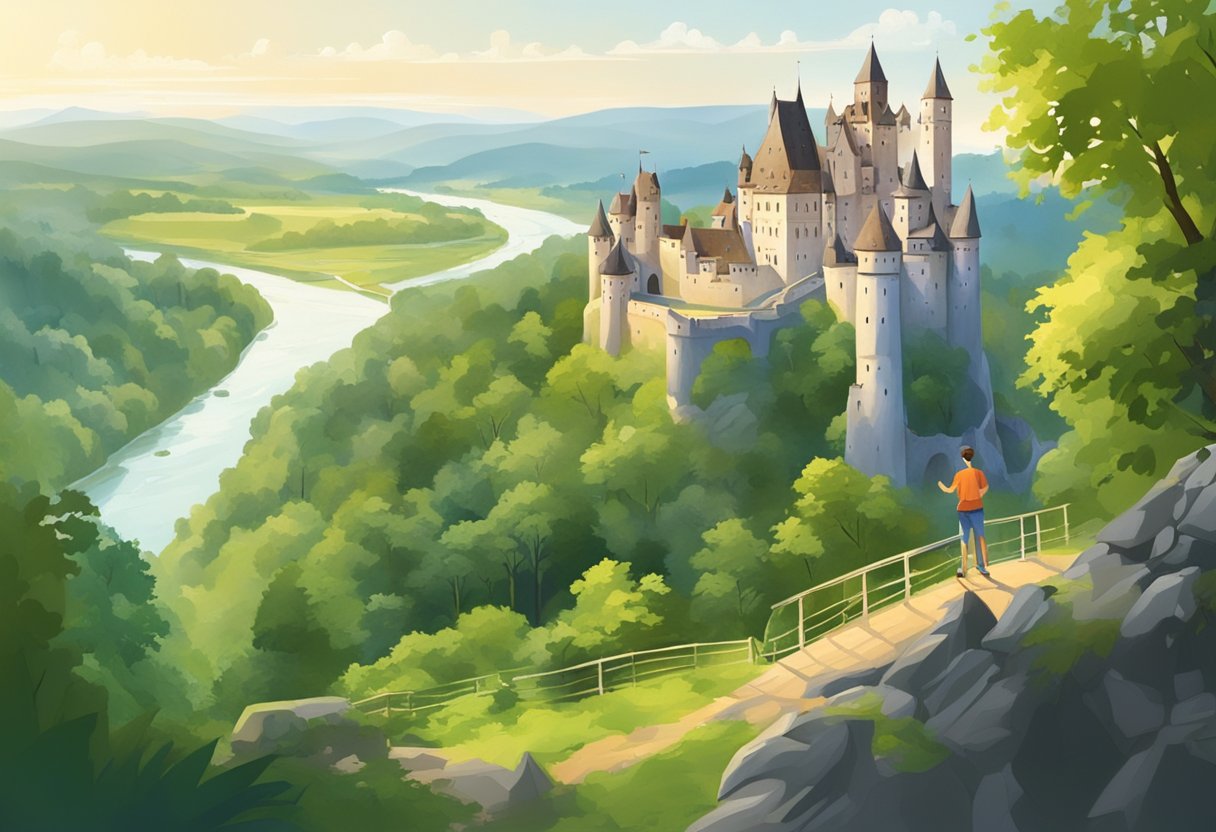Exploring the timeless majesty of German castles offers an adventurous peek into the past, where every stone tells a tale more intriguing than fiction. These formidable fortresses and opulent palaces dot the German landscape, inviting tourists from around the world to revel in their historical splendor.
From the fairy tale spires of Neuschwanstein to the medieval might of Burg Eltz, Germany’s castles captivate the imagination, transporting visitors to an era where knights roamed and royalty reigned supreme.

Venturing through Germany in search of these architectural marvels is akin to stepping into a storybook, with each castle having its own unique narrative and enchanting characteristics. To navigate through a tapestry of turrets, tourists can embark on scenic road trips, romantic river cruises, or even picturesque hikes.
Such journeys aren’t just a feast for the eyes—they’re an all-you-can-eat buffet for the soul, seasoned with a touch of historical grandeur and a sprinkle of European charm.
A sojourn to these iconic landmarks isn’t just a to-do item; it’s a must-do spectacle. Whether meandering along the Rhine or scaling the Bavarian Alps, an expedition of Germany’s castles is a bucket-list worthy escapade that promises a treasure trove of memories.
Behold these stone guardians of yesteryear and discover the rich tapestry of tales they have woven through centuries.
Key Takeaways
- German castles offer a fascinating glimpse into Europe’s medieval history and architecture.
- Planning and various modes of travel can enhance the sightseeing experience for castle enthusiasts.
- Visiting German castles is a culturally enriching experience, steeped in history and beauty.
Planning Your Castle Quest
Embarking on a castle quest across Germany is no small feat. One must carefully select from an array of majestic structures, each boasting its own slice of history.
Whether one seeks the fairy-tale allure of Neuschwanstein Castle or the robust might of Hohenzollern, a methodical approach will serve one well.
Choosing the Castles
- Neuschwanstein Castle: A must-see for its iconic towers that inspired Disney’s Cinderella Castle, offering postcard views.
- Cochem Castle (Reichsburg Cochem): Venture to this hilltop for a taste of medieval grandeur and scenic Rhine vistas, which you can explore more about through a dedicated guide.
- Hohenzollern Castle: Feel like nobility as you wander this ancestral seat of Prussian kings, steeped in Renaissance elegance.
- Lichtenstein Castle: Discover the “Little Neuschwanstein,” perched on a cliff, evoking storybook fantasies.
- Heidelberg Castle: Soak in Renaissance romance among the ruins and enjoy a captivating walk through history.
- Burg Eltz: Tucked in nature, it’s one of the few castles in the Rhineland that has never been destroyed.
Itinerary and Travel Tips
- Guidebook: Arm oneself with a guidebook; the more dog-eared and coffee-stained, the better. It will be a testament to one’s adventurous spirit.
- Transportation: Skip the dragon, and instead, consider renting a car or hopping on a train. Check the local river cruise options for an enchanting journey along the Rhine.
- Accommodation: Book lodgings in medieval towns near castles for full immersive experience. Overnight in a Burg if one dares!
- Timing: To enjoy fewer crowds and better views, visit during the shoulder seasons.
One should lace up their sturdiest walking shoes—hearty medieval stone doesn’t take kindly to dainty footwear—and take to the rolling hills with a sense of humor and adventure. They won’t simply be seeing castles; they’ll be time-traveling!
The Enchanted Experience
Visiting German castles is like stepping into a storybook where every stone whispers legends, and each corridor promises adventure. Whether one prefers the meticulous insights of a guided tour or the freedom of solo exploration, the country’s historic castles offer an unforgettable journey through time.
Guided Tours vs Solo Explorations
Guided Tours:
- Pros: The storytelling prowess of a seasoned guide can bring the silent walls to life. Imagine walking through Neuschwanstein’s opulent rooms while a guide recounts tales straight out of a fairytale—tales of secret passages, whispered conspiracies, and the eccentric king who envisioned it all.
- Cons: One may feel like a knight in shining armor, all chained up, when shackled to a tour’s strict timeline.
Solo Explorations:
- Pros: They say that in the right light, at the right time, the forest around a castle ruin whispers more than any guide ever could. Solo adventurers can saunter through Baroque gardens and climb to the highest towers at their own whimsical pace.
- Cons: Beware, for one might miss the forest for the trees—or in this case, miss the significance of the ancient armor collection without a knowledgeable bard by their side.
Seasonal Spectacles
- Spring & Summer:
- The castles’ gardens are in full bloom; it’s a riot of colors with a scent so intoxicating even the staunchest knight might swoon. The sun-kissed towers cast long shadows, and the outdoor festivities are nothing short of royal.
- Fall & Winter:
- As the forests don a golden crown, the castles stand tall, flaunting their time-tested battlements. If one’s lucky, a dusting of snow turns everything into a picturesque fairytale landscape, making Neuschwanstein look like it’s been frosted by a particularly artistic giant.
Whether one is gallivanting through grand halls clad in historical furnishings or pondering the solitude of castle ruins deep in the forest, the German castle experience is an enchanted encounter with history, beauty, and the occasional ghost of yore.
Behind the Stone Walls
When one steps through the heavy wooden doors of a German castle, they are not just entering a building, they are stepping into a time machine. Here, the stone walls don’t just talk; they practically narrate an epic, complete with dramatic battles and royal whispers.
Castle Architecture and Design
The architects of yesteryear surely knew how to make an impression. Take, for instance, the spires of Schwerin Castle, which look as though they’ve leapt straight out of a storybook.
Then there’s the Wernigerode Castle, perched atop a hillside, providing sweeping views of the town below. Castles along the Moselle River remind us that location was always part of the design; these strongholds were not just homes, but strategic points for defense (and impressive postal codes).
- Burg Eltz Castle: A medieval marvel that looks much like it did when it rolled off the Middle Ages’ castle production line.
- Reichsburg Castle: Rebuilt in the 19th century, it retains a commanding, hilltop position over Cochem and the Moselle.
- Mespelbrunn Castle: A quieter, yet charming moated castle, hidden in the dense forests of the Spessart.
These stone guardians feature an array of architectural styles, from Romanesque to Baroque, each with strategic and aesthetic quirks. And the fun doesn’t stop at the facade. Inside, you might find solace in a stout, stone fortress or fanciful flights of fancy in a neo-Gothic palace.
Historical Echoes
The walls of German castles have absorbed centuries of history. Walk into Burg Eltz and one might hear echoes of clanking armor as knights prepare for war.
Or perhaps catch a chilly draft in the Swabian Alps near Hohenzollern Castle, where rumors swirl of royal ghosts earning their haunt miles. A stroll through the castle grounds could reveal murals of medieval conquests, while embattled walls bear the pockmarks of past skirmishes.
- Paintings: Often depict kings and courtly life, transporting viewers back to the sumptuous, if not slightly treacherous, atmosphere of the Middle Ages.
- Cochem Castle: Its restoration has been so meticulous that one might expect a medieval king to round the corner at any moment.
These stone structures were more than just homes; they were powerful symbols of wealth and influence. Each turret, each gate, every narrow window opening onto a world of historical intrigue and royal dramas, seasoned with a hint of humor—for what is a King without his court jester or a Queen without her not-so-secret stash of decadent desserts?
Beyond the Battlements
The adventure through Germany’s castles doesn’t stop at the towering spires and thick stone walls. Culture vultures and gourmands alike will find that the real treasures sometimes lie outside the fortifications.
Cultural Excursions
Visiting German castles provides a perfect springboard to dive into a rich cultural tapestry. Should one find themselves near Stuttgart, the delicate art of porcelain making invites for a fascinating excursion. It’s not just plates and vases, though; one may stumble upon museums that showcase ornate furniture that once graced castle halls or weapons that echo tales of historic battles.
- Museum marvels: In Bavaria, museums don’t shy away from extravagance. From knight’s armors to contemporary art, it’s like walking through history but with fun facts instead of exams.
- Castle hotels: For those wanting to sleep like a sovereign, many castles have been converted into castle hotels. Imagine resting in a royal chamber with the legacy of past monarchs tucked in alongside you.
- A historical stroll through Frankfurt: They may be known for their bustling commerce, but one should not overlook Frankfurt’s historical landmarks that whisk walkers back in time.
Local Delicacies and Souvenirs
As you meander through the Rhine Valley, the vineyards beckon with a glass of the local grapes – a sip of history, if you will. Merchants in castle shops compete with treasures of their own. They don’t duel with swords but with souvenirs that capture Germany’s charm.
- Vineyard ventures: Should one’s travel tales lean toward the spirited kind, the vineyards offer a palette of local flavors. Remember, in Germany, wine tasting is considered a noble research activity.
- Shop ’til you hop: Castle shops throughout Germany are treasure troves, especially for visitors from America looking for that quintessential memento. Porcelain miniatures? Check. Replica medieval weapons? Definitely more airport-friendly than the real ones.
A table worthy of a king’s feast, mapping out where to snag these Germanic gems:
| Souvenir | Location | Description |
|---|---|---|
| Porcelain | Stuttgart & beyond | Intricate craftsmanship in every piece, reminiscent of royal décor. |
| Wine | Rhine Valley & surrounding areas | Vineyards offering a tasty journey through Germany’s viticulture. |
| Weapons | Fortress gift shops | Miniature swords and armor pieces, channeling one’s inner knight. |
Remember, one hasn’t truly experienced German castles until they’ve ventured beyond the battlements to embrace the stories, savor the flavors, and return home with a suitcase full of history (and perhaps a few bottles of Riesling).


Leave a Reply